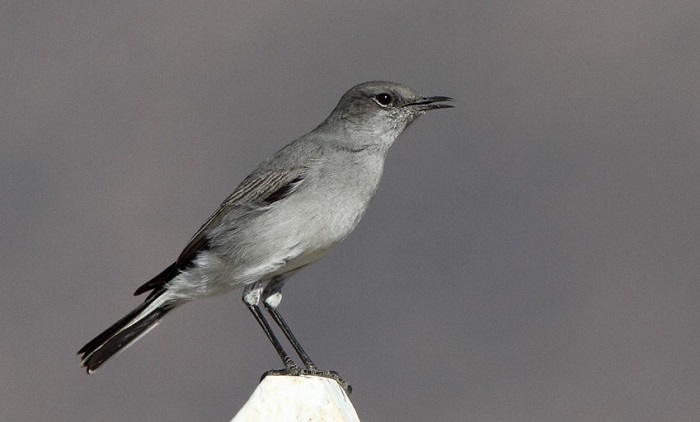Cover image of Karoo Chat by Desire Darling – Mountain Zebra National Park, Eastern Cape – BirdPix No. 38935
Identification
The Karoo Chat is larger and longer-tailed than other similar chats and the sexes are alike. It has a noticeably horizontal posture, unlike the typically upright posture of other chats.
The key identification feature is the black tail with white outer-tail feathers and a grey rump. This combination along with the greyish body is diagnostic.
The overall colouration is dark and light grey. The ear coverts are rufous-grey but this is not always conspicuous in the field. The bill, legs and feet are dark-grey-black. Birds from Namibia are smaller and much paler with sandy-buff upperparts, off-white underparts and pale whitish rumps.

Near Uniondale, Western Cape
Photo by Pamela Kleiman
Juveniles are spotted with buff on the upperparts and the underparts are mottled blackish with buff spotting.

This is a young bird, with buff-tipped feathers on the back and dark mottling on the front.
Near Calvinia, Northern Cape
Photo by Tino Herselman
The Karoo Chat is similar to some other chats. It is most easily mistaken for the grey form of the Mountain Chat Oenanthe monticola but that species is darker grey and has a white (not grey) rump.
The Tractrac Chat (Emarginata tractrac) is normally much paler and has a whitish rump and extensive white on the sides of the tail. Note that Namibian forms of the Karoo Chat are paler than their southern counterparts and have off-white not grey rumps. They can be separated from the Tractrac Chat by their longer, more extensively black tails and horizontal posture.
The Sickle-winged Chat (Emarginata sinuata) has buffier plumage and a pale rufous rump and outer tail.

Tanqua Karoo National Park, Western Cape
Photo by Trevor Hardaker
Status and Distribution
A common resident, the Karoo Chat is near-endemic to southern Africa and is well named because it is virtually restricted to the Karoo biomes and the similarly semi-arid escarpment of Namibia and south-western Angola. Its population density is highest in the Succulent Karoo and western Nama Karoo where it is one of the commonest species in its habitat.
Its distribution is not believed to have changed historically and this common species is not under any threat.

Details for map interpretation can be found here.
Habitat
The Karoo Chat inhabits Karroid, semi-arid scrub in both the winter and summer rainfall regions and has a preference for stony ground. It is found both on the flats and on broken ground or stony hillsides, but avoids mountainous habitat. It is rare in towns, villages and gardens.

Photo by Ryan Tippett
Behaviour

Jurgensfontein Farm
Photo by Gerald Wingate
The Karoo Chat is sedentary but is known to undertake some local movements in response to rain.
It is usually seen singly or in pairs, and occasionally in family groups. It can be tame and fairly confiding and perches prominently on shrubs, small trees or fence posts. Sometimes flicks wings, but not as regularly as Familiar or Sickle-winged Chats. It is generally conspicuous and aggressively chases off conspecifics and other species that may compete with it for food. When disturbed, flies low, in undulating flight, from perch to perch and flutters wings upon landing until balanced
It forages on the ground around grass tufts and at the base of shrubs. Also hunts from a perch, diving to the ground to snap up prey. Feeds mainly on invertebrates including spiders, solifuges, millipedes, centipedes, grasshoppers, crickets, bugs, beetles, ants, termites, flies, snails and caterpillars. Also consumes some seeds and small fruits.

Karoo National Park, Western Cape
Photo by Pamela Kleiman
The Karoo Chat breeds during spring and summer, often opportunistically after rain in arid areas. It is a territorial, solitary nester. The nest is a deep cup, the outside of which is built with soft plant material and the interior is generously lined with fluffy seeds and other soft plant material. The nest is seemingly built only by the female and is placed on the ground under a shrub. Two to four eggs are laid per clutch; however, further details regarding incubation are unrecorded. The young are fed and provided for by both sexes.

Renosterkop Farm, Northern Cape
Photo by Les Underhill
Further Resources
Species text adapted from the first Southern African Bird Atlas Project (SABAP1), 1997.
The use of photographs by Desire Darling, Gerald Wingate, Les Underhill, Pamela Kleiman, Tino Herselman, Trevor Hardaker and Zenobia van Dyk is acknowledged.
Virtual Museum (BirdPix > Search VM > By Scientific or Common Name).
Other common names: Karoospekvreter (Afrikaans); Traquet du Karoo (French); Bleichschmätzer, Wüstenschmätzer (German); Karoo-spekvreter (Dutch); Chasco do Karoo (Portuguese)
Recommended citation format: Tippett RM 2023. Karoo Chat Emarginata schlegelii. Biodiversity and Development Institute. Available online at http://thebdi.org/2023/06/03/karoo-chat-emarginata-schlegelii/
List of bird species in this format is available here.

Montagu District, Western Cape
Photo by Zenobia van Dyk

